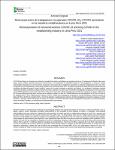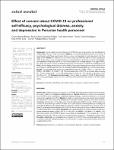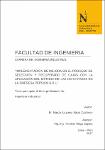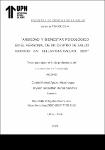Mostrar el registro sencillo del ítem
Reincorporation of recovered workers COVID-19 and long COVID in the metalworking industry in Lima Peru 2021 [Reincorporación de trabajadores recuperados COVID-19 y COVID persistente en la industria metalmecánica en Lima Perú 2021]
| dc.contributor.author | Dávila Morán, Roberto Carlos | |
| dc.contributor.author | Agüero Corzo, Euris del Carmen | |
| dc.contributor.author | Velarde Dávila, Leonardo | |
| dc.contributor.author | Portillo Rios, Héctor | |
| dc.contributor.author | Ruiz Nizama, José Leonor | |
| dc.contributor.author | Guanilo Paredes, Carlos Enrique | |
| dc.contributor.author | Guillén Pedraza, Félix Román | |
| dc.date.accessioned | 2021-11-18T00:15:52Z | |
| dc.date.available | 2021-11-18T00:15:52Z | |
| dc.date.issued | 2021-10-11 | |
| dc.identifier.citation | Dávila, R. C., ...[et al.]. (2021). Reincorporation of recovered workers COVID-19 and long COVID in the metalworking industry in Lima Peru 2021 [Reincorporación de trabajadores recuperados COVID-19 y COVID persistente en la industria metalmecánica en Lima Perú 2021]. Boletin de Malariologia y Salud Ambiental, 61(3). https://doi.org/10.52808/bmsa.7e5.613.014 | es_PE |
| dc.identifier.uri | https://hdl.handle.net/11537/28465 | |
| dc.description.abstract | RESUMEN El COVID persistente se caracteriza por síntomas y secuelas funcionales y psicológicas que persisten por más de 12 semanas post infección, tales como: fatiga, disnea, ansiedad, depresión; generando inconvenientes en la reanudación de actividades laborales de los trabajadores. Se realizó un estudio epidemiológico descriptivo de corte transversal, evaluando la reincorporación de trabajadores operadores de industrias metalmecánicas de Lima, Perú; recuperados y COVID persistentes, entre el tercer trimestre 2020 y primer trimestre 2021. Se aplicaron las escalas de disnea de Borg y la escala de disnea modificada del Medical Research Council (mMRC), además de la escala de ansiedad y depresión de Goldberg. Los resultados se analizaron mediante estadística descriptiva, empleando medidas de tendencia central y dispersión. Se observó que más del 80% de trabajadores recuperados son reincorporados; y para COVID persistente se reincorpora entre 75% y 43% para los cargos 8121 y 8122, respectivamente. El esfuerzo respiratorio en reposo resultó normal por la escala de Borg para cada grupo, mientras que en esfuerzo se obtuvo un valor R2= 0.2986 indicando la no reincorporación en 74,51% y 43,33% en las categorias 8121 y 8122, respectivamente; además 45,12% y 42,68% de los trabajadores recuperados y COVID persistentes mostraron sintomas de fatiga; 36,25% y 35,26% de ansiedad; 25,4% y 15,21% de depresión, respectivamente; asimismo, el total de trabajadores presentaron sobrepeso con IMC promedio > 26 Kg/m2; siendo más elevado en mujeres (27,4 Kg/m2). El COVID-19 afecta la salud de trabajadores (recuperados y COVID persistentes), reduce el reintegro al trabajo y en consecuencia la productividad de las empresas. | es_PE |
| dc.description.abstract | ABSTRACT Persistent COVID is characterized by functional and psychological symptoms and sequelae that persist for more than 12 weeks post infection, such as: fatigue, dyspnea, anxiety, depression; generating inconveniences in the resumption of work activities of workers. A descriptive, cross-sectional epidemiological study was carried out, evaluating the reincorporation of workers operating in metalworking industries in Lima, Peru; recovered and persistent COVID, between the third quarter 2020 and the first quarter 2021. The Borg dyspnea scales and the modified dyspnea scale of the Medical Research Council (mMRC) were applied, in addition to the Goldberg anxiety and depression scale. The results were analyzed using descriptive statistics, using measures of central tendency and dispersion. It was observed that more than 80% of recovered workers are reinstated; and for persistent COVID, between 75% and 43% are reinstated for charges 8121 and 8122, respectively. Respiratory effort at rest was normal by the Borg scale for each group, while in effort a value R2 = 0.2986 was obtained, indicating no reincorporation in 74.51% and 43.33% in categories 8121 and 8122, respectively; also 45.12% and 42.68% of the recovered workers and persistent COVID showed symptoms of fatigue; 36.25% and 35.26% anxiety; 25.4% and 15.21% of depression, respectively; Likewise, the total of workers were overweight with an average BMI> 26 Kg / m2; being higher in women (27.4 Kg / m2). COVID-19 affects the health of workers (recovered and persistent COVID), reduces return to work and consequently the productivity of companies. | es_PE |
| dc.format | application/pdf | es_PE |
| dc.language.iso | spa | es_PE |
| dc.publisher | Universiad de Carabobo | es_PE |
| dc.rights | info:eu-repo/semantics/openAccess | es_PE |
| dc.rights | Atribución-NoComercial-CompartirIgual 3.0 Estados Unidos de América | * |
| dc.rights.uri | https://creativecommons.org/licenses/by-nc-sa/3.0/us/ | * |
| dc.source | Universidad Privada del Norte | es_PE |
| dc.source | Repositorio Institucional - UPN | es_PE |
| dc.subject | Fatiga | es_PE |
| dc.subject | Depresión | es_PE |
| dc.subject | Ansiedad | es_PE |
| dc.subject | Covid-19 | es_PE |
| dc.subject | Trabajadores | es_PE |
| dc.title | Reincorporation of recovered workers COVID-19 and long COVID in the metalworking industry in Lima Peru 2021 [Reincorporación de trabajadores recuperados COVID-19 y COVID persistente en la industria metalmecánica en Lima Perú 2021] | es_PE |
| dc.type | info:eu-repo/semantics/article | es_PE |
| dc.publisher.country | VE | es_PE |
| dc.identifier.journal | Boletin de Malariologia y Salud Ambiental | es_PE |
| dc.description.peer-review | Revisión por pares | es_PE |
| dc.subject.ocde | https://purl.org/pe-repo/ocde/ford#2.11.04 | es_PE |
| dc.description.sede | Los Olivos | es_PE |
| dc.identifier.doi | https://doi.org/10.52808/bmsa.7e5.613.014 |







